Set Up Marketing Intelligence
Learning Objectives
After completing this unit, you’ll be able to:
- Explain what Marketing Intelligence is and why it matters.
- Identify the roles and permissions needed to use Marketing Intelligence.
- Set up Marketing Intelligence by enabling required features and installing the app.
Meet Alex: A Marketer Ready to Level Up with Marketing Intelligence
Alex is a marketing manager at Acme Corp who wants clear visibility into how Acme’s marketing campaigns contribute to business outcomes. But with its marketing data scattered across different platforms, channels, business units, and campaigns, it’s hard to see how campaigns drive sales impact, which is Alex’s main key performance indicator (KPI).
Every platform, whether social, search, or email, speaks its own language, with unique reporting formats, data structures, and metrics. To make impactful, data-driven decisions, Alex needs to align these sources for a clear, unified view of performance.
With Marketing Intelligence, Alex can bring data together, analyze performance, get clear insights, and optimize toward Acme’s goals without switching between tools. Follow Alex’s journey to set up Marketing Intelligence in your Salesforce org and start unlocking those insights.
What Is Marketing Intelligence?
Marketing Intelligence is a powerful agentic marketing analytics and business intelligence solution within Marketing Cloud Next. It helps marketers bring together data from media platforms, CRM systems, and analytics tools. With all the data in one place, marketers can analyze, visualize, and report on performance.
Because it’s built on the Salesforce Platform, Marketing Intelligence works seamlessly with other Salesforce clouds, like Sales Cloud. This makes it easier for marketers to measure real business impact with features such as attribution. Under the hood, Marketing Intelligence runs on Tableau Next. It uses the Tableau Semantic Layer to keep reports and dashboards consistent and flexible.
Marketing Intelligence brings together the power of Data Cloud, Agentforce, Einstein AI, and Tableau Next to continuously connect, harmonize, and transform your marketing data into proactive, trusted insights—all within your flow of work. With Marketing Intelligence, you can make smarter decisions that improve campaign performance, reduce wasted spend, and save time.
What You Need Before You Start
Before you set up Marketing Intelligence, make sure you have the necessary roles and permissions to access the data and features. Marketing Intelligence includes three standard permission sets for these roles: Admin, Data Specialist, and Marketing Manager.
User Type - Label |
Description |
Required Permission Sets |
|---|---|---|
Marketing Intelligence Admin |
The admin has full access to configure all Marketing Intelligence features, including setting up and installing the Marketing Intelligence semantic model and application. |
|
Marketing Intelligence Data Specialist |
Data specialists set up and maintain data sources in Marketing Intelligence using file-based or API connections. They build and manage data pipelines by mapping fields, managing classification sources, and applying harmonization rules—ensuring data is accurate, consistent, and ready for reporting. |
|
Marketing Intelligence Marketing Manager |
Marketing managers use Marketing Intelligence to view and create marketing goals, explore performance dashboards, and analyze data through reports, segmentation tools, filters, and visualizations to evaluate campaign impact and guide decisions. |
|
Install Marketing Intelligence
After Marketing Intelligence is provisioned, the admin installs it and assigns permissions to the relevant users.
- From Setup, in the Quick Find box enter
Marketing Intelligence.
- Select Marketing Intelligence.
- Go to the Setup Prerequisites tab.
- Enable Data Cloud.
- In Data Cloud, review and confirm Data Governance settings. All Marketing Intelligence objects must be allowed to enable access to the Marketing Intelligence semantic model.
- Enable Tableau Next.
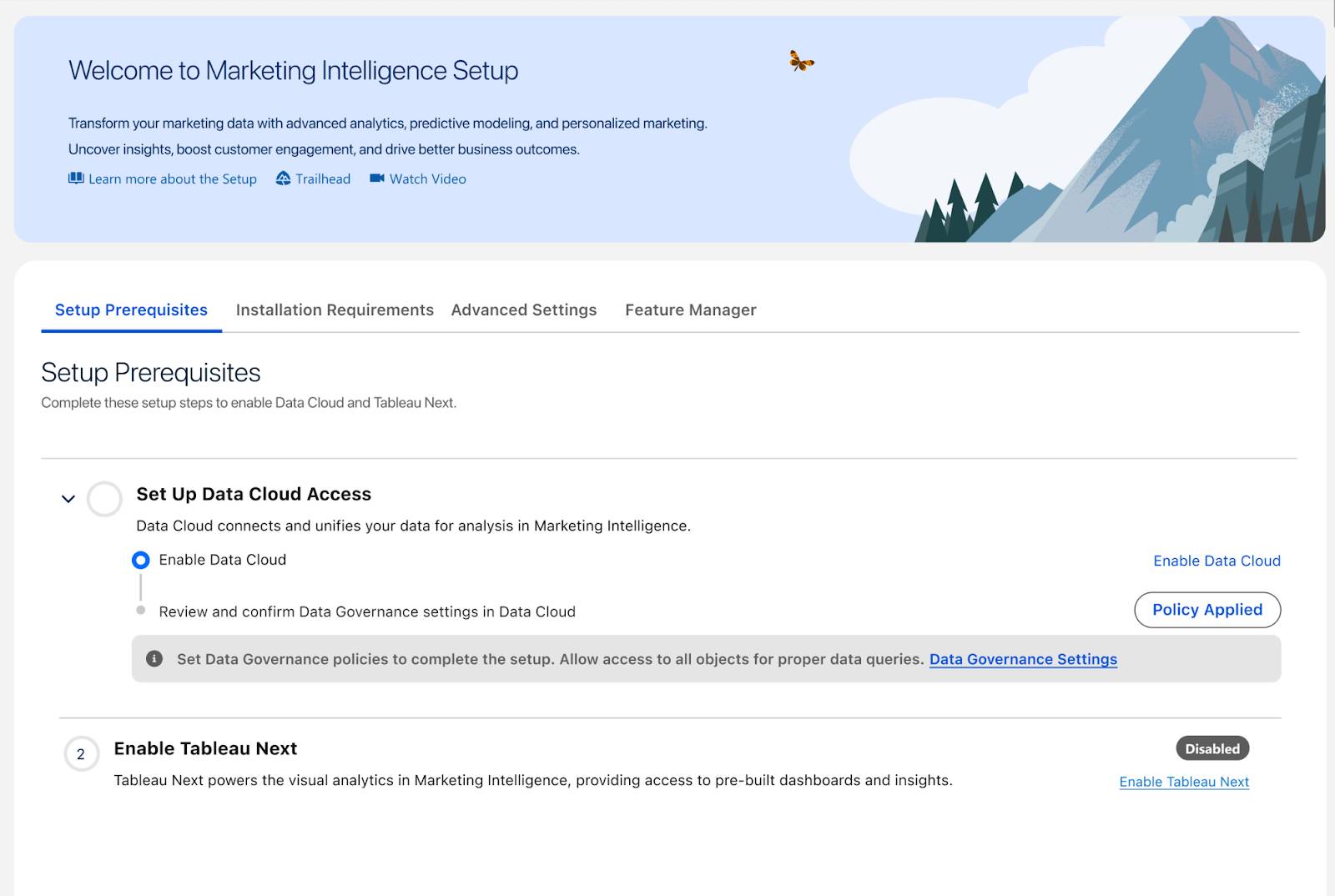
Since Data Cloud is already enabled at Acme Corp, the admin just enables Tableau Next. With these core services active, the team can install the essential components that power Marketing Intelligence.
Installation Requirements
With the setup prerequisites complete, Acme Corp’s admin moves on to installing the foundational components of Marketing Intelligence. This step lays the technical foundation for Alex to start connecting and analyzing marketing data.
From the Installation Requirements tab, the admin:
- Installs the Tableau Next workspace.
- Sets up the required data spaces.
- Enables Marketing Intelligence.
These components ensure that the right infrastructure is in place to support data pipelines, campaign tracking, and performance analysis. With the core setup complete, Alex and the team are ready to configure advanced settings to tailor Marketing Intelligence to their business needs.
Customize Advanced Settings
Alex wants insights tailored to Acme Corp’s industry and the ability to connect campaign data to conversions. You can configure these advanced options to do the same.
From the Advanced Settings tab, the admin:
- Selects the business type and industry to tailor benchmarks and reports
- Enables the Einstein LLM Gateway for AI-powered campaign summaries and data enrichment
- Completes Campaign Attribution setup to link campaigns with website conversions
- Enables Segment Intelligence to easily track, compare, and optimize audience engagement across marketing channels
These advanced settings unlock powerful AI capabilities and reporting features that help Alex and the team gain more accurate insights and take smarter actions.
Set Up Marketing Intelligence Attribution
Now that Acme Corp’s admin has customized the advanced settings, Alex can see how Acme’s campaigns influence revenue from the first touch to the final sale. This can be done using Marketing Intelligence Attribution, one of the most valuable capabilities in Marketing Intelligence.
Marketing Intelligence Attribution helps Alex connect media spend to revenue by linking campaign engagement with conversion events and customer relationship management (CRM) outcomes. It supports single-touch attribution, either first or last touch, to help the team identify which campaigns contribute most to key conversions.
To set it up:
- Create a new attribution
- Go to the Data Management tab and select Attribution.
- Click New Attribution.
- Go to the Data Management tab and select Attribution.
- Configure the attribution.
- Select the Data Space, CRM connection, lookback window, and attribution model (First Touch or Last Touch)
- Click Save.
- Select the Data Space, CRM connection, lookback window, and attribution model (First Touch or Last Touch)
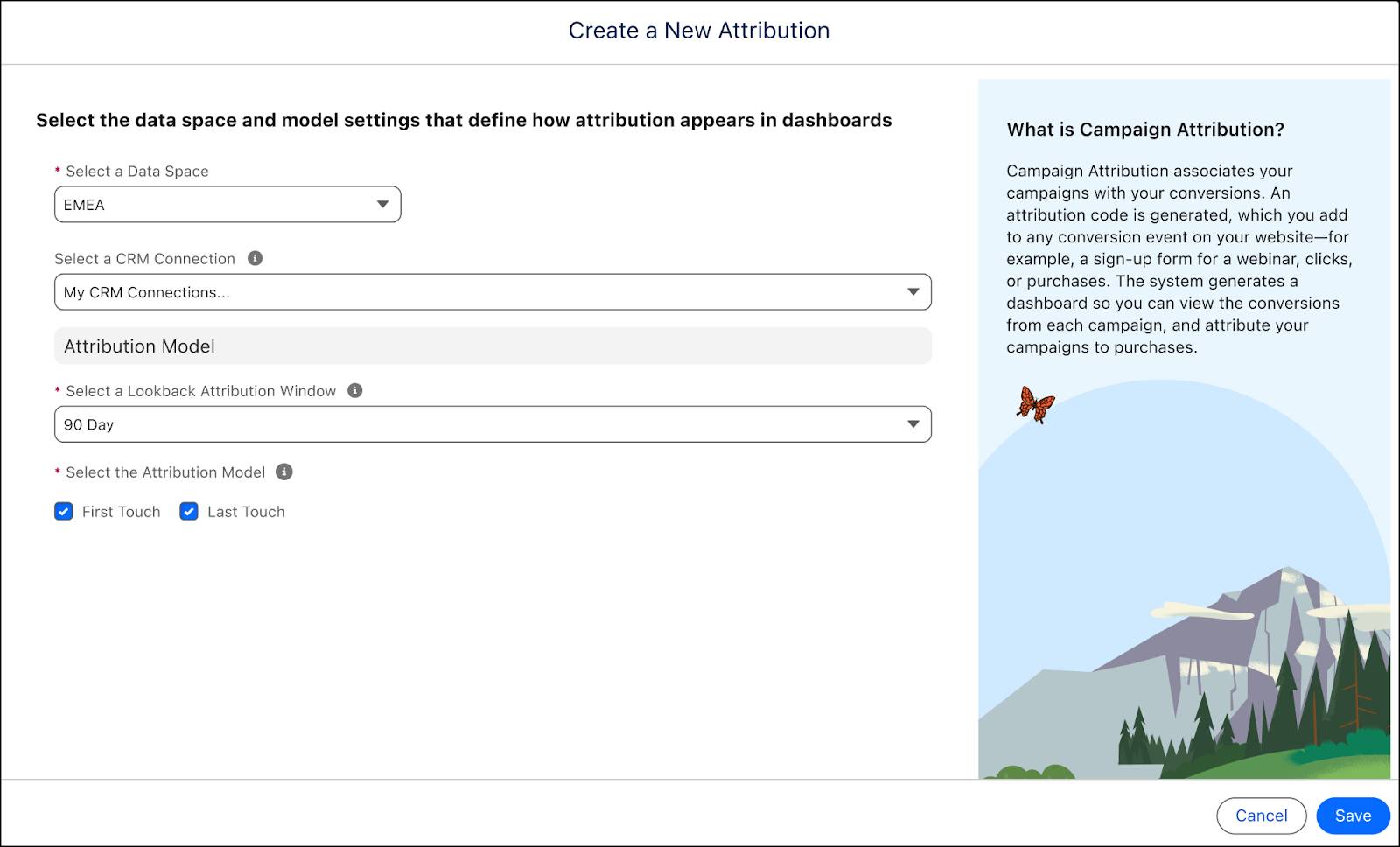
- Set the attribution touchpoints using standard or custom data. For custom data, map the attribution model.
- Configure your leads data
- Select the lead data type: standard or custom.
- Define statuses using standard Salesforce CRM objects, or classify manually.
- Select the campaign name field in your Lead object. If the object isn’t listed, upload it using Data Cloud.
- For custom lead objects, map the data lake object (DLO) fields to the CRM’s lead fields.
- Select the lead data type: standard or custom.
- Configure your opportunities data
- Select the opportunity data type: standard or custom.
- For custom opportunity objects, map the DLO fields to the CRM’s opportunity fields.
- Classify opportunity stages.
- Select the opportunity data type: standard or custom.
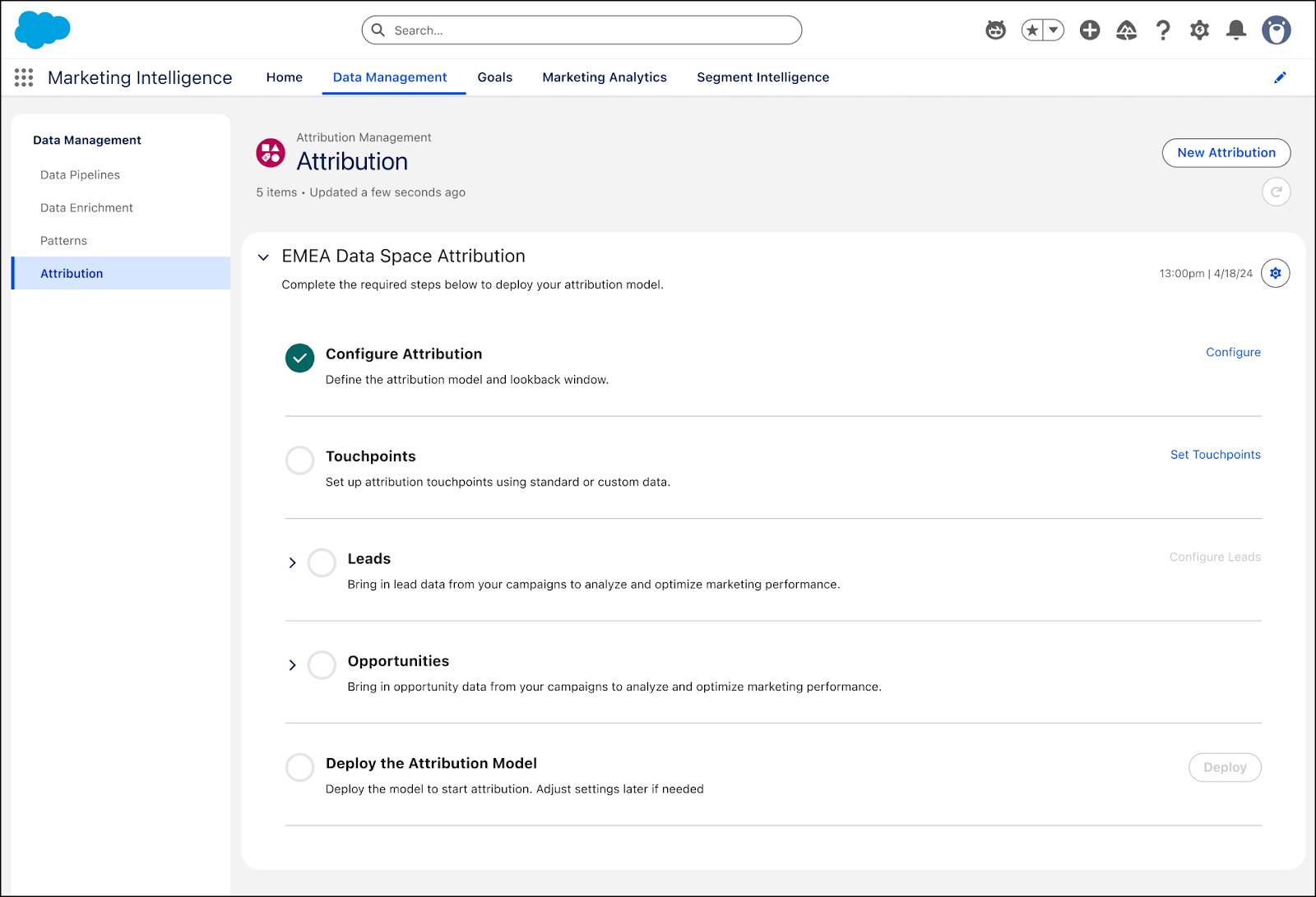
- Deploy the Attribution Model.
- Copy the Web SDK code and embed it into a website conversion event, such as a sign-up form for a webinar. For more information, see Salesforce Help: Create a New Attribution in Marketing Intelligence.
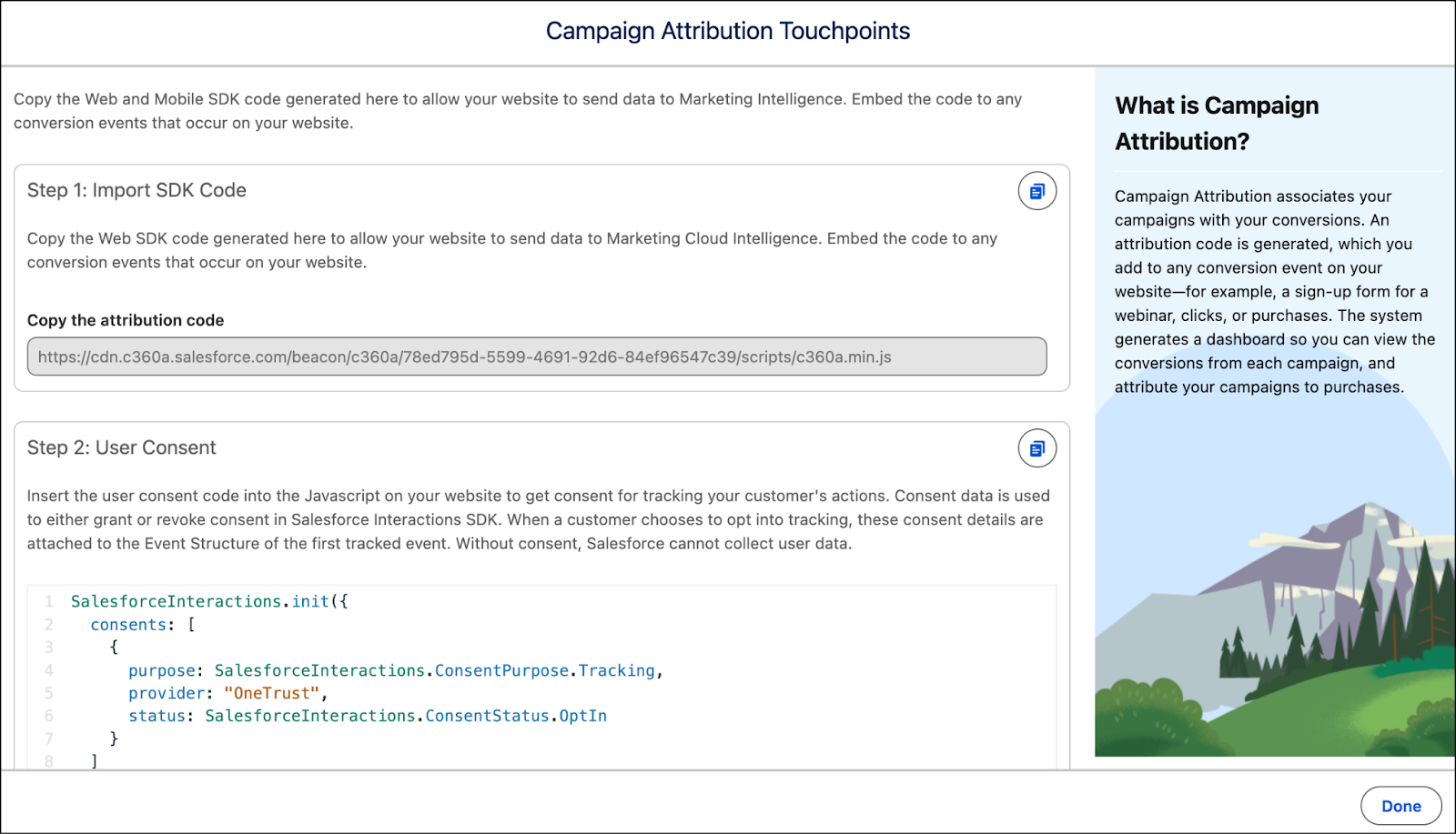
Alex can now analyze Acme’s attribution data in the Marketing Analytics tab.
Review and Enable Beta Features
With the core setup complete, Acme Corp’s admin reviews optional beta features that can extend the functionality of Marketing Intelligence. These features can be enabled or disabled at any time from the Feature Manager tab.
The available beta features include:
-
Goals—Enable goals to track and monitor your marketing KPIs directly in Marketing Intelligence.
-
Patterns—Organize and structure your data more efficiently by defining consistent patterns across your datasets.
-
Agentforce—Streamline campaign optimization with Agentforce, including automated insights and recommendations such as the Paid Media Optimization Agent.
-
Connectors—Connect third-party data sources to Marketing Intelligence for a more unified view of campaign performance.
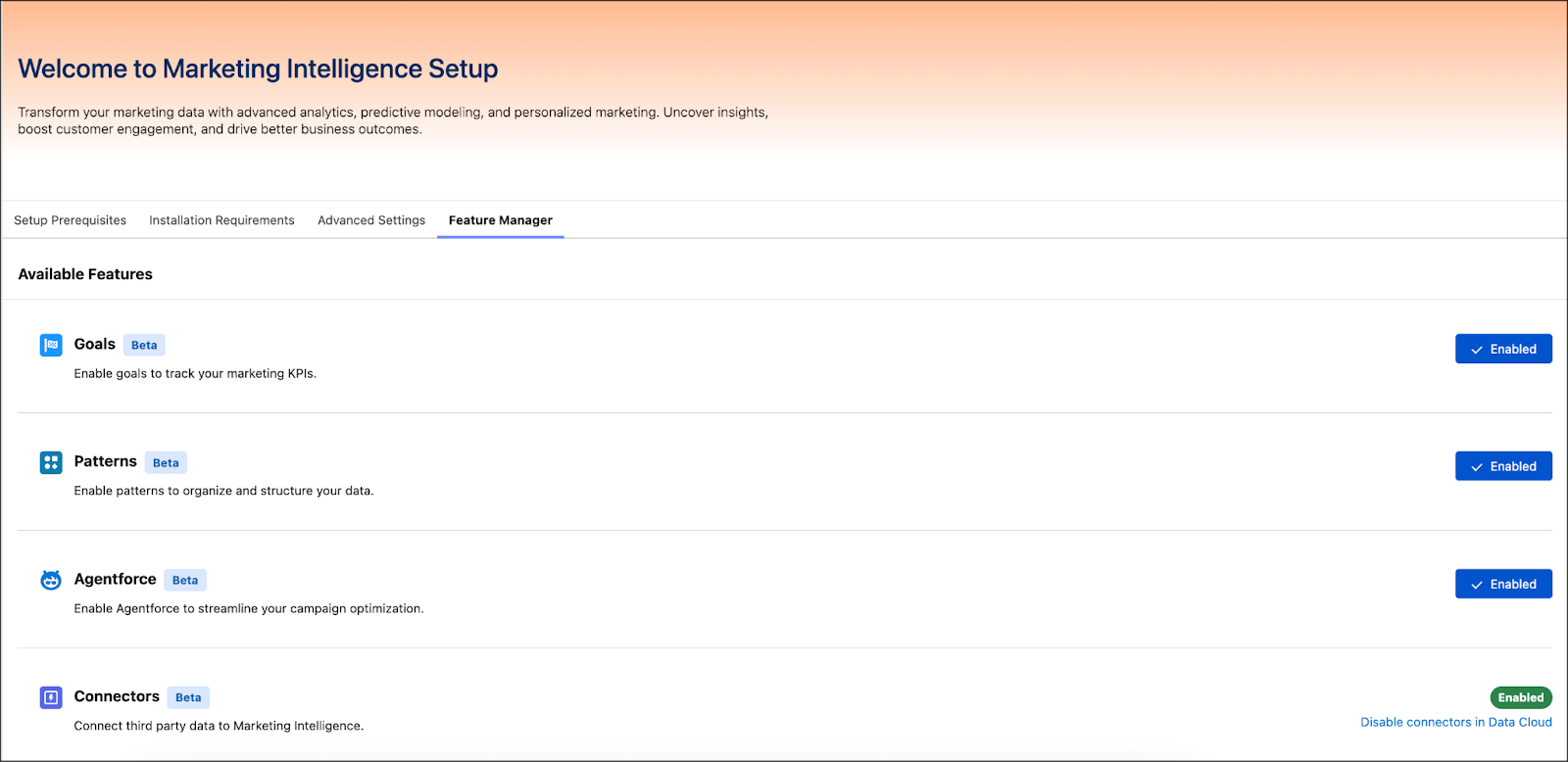
Once the admin enables the desired features, Alex and the team can begin exploring additional capabilities to further customize and optimize their Marketing Intelligence experience.
Marketing Intelligence is now up and running for Alex and the Acme Corp team. With attribution activated and advanced settings configured, Alex is ready to connect third-party platforms and internal data sources. This gives the team a unified, accurate view of campaign performance across their entire marketing stack.
What’s Next?
You learn how to connect data from multiple sources like ad platforms and internal reports, so Marketing Intelligence can fuel dashboards with consistent, reliable insights.